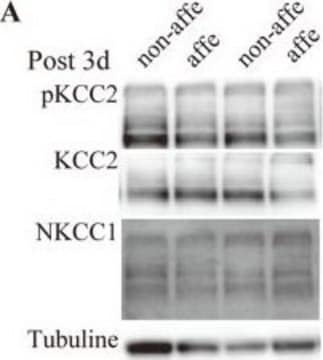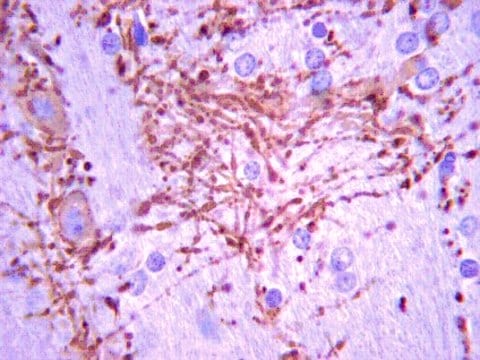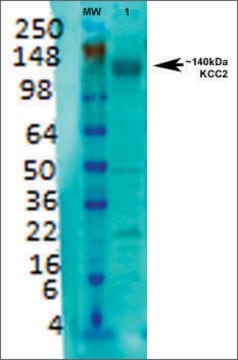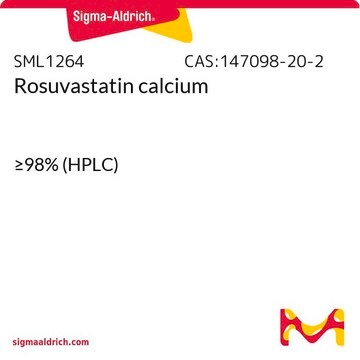推荐产品
生物源
rabbit
品質等級
共軛
unconjugated
抗體表格
IgG fraction of antiserum
抗體產品種類
primary antibodies
無性繁殖
polyclonal
形狀
buffered aqueous solution
物種活性
canine, rat
技術
western blot: 0.5-2.0 μg/mL using rat brain membrane preparation
UniProt登錄號
運輸包裝
dry ice
儲存溫度
−20°C
目標翻譯後修改
unmodified
基因資訊
rat ... Slc12a5(171373)
一般說明
Transporters and exchangers play a critical role in the generation and dissipation of action potentials in nerve cells and in the maintenance of normal cell volume. They are also involved in a variety of mechanisms pertaining to the control of neuronal growth, maturation, synaptic plasticity and neuroendocrine functions
The cation-chloride cotransporters (CCCs) are glycoproteins involved in transport of ions, including chloride, across the cell membrane without an accompanying net charge movement; thus this type of transport is driven without the direct hydrolysis of ATP. The energy for the transport is derived from the cation gradient generated by the Na+/K+/ATPase. The CCCs also play a critical role in influencing GABA- and glycine-mediated signaling. Other transporters that participate in chloride homeostasis include Na+-dependent and Na+-independent anion exchangers, which exchange chloride for HCO3- ions
Three cotransporters belonging to this family include sodiumchloride( Na+/Cl-/ ) cotransporters (NCCs), sodiumpotassium-chloride (Na+/K+/2Cl-) cotransporters (NKCCs) and potassium-chloride (K+/Cl-) cotransporters (KCCs). K+/Cl- cotransporter (KCC2) is the major neuronal chloride transporter. It has been proposed to play a role in the modulation of neuronal responses to γ-aminobutyric acid (GABA). GABA-mediated fasthyperpolarizing inhibition depends on extrusion of chloride by KCC2 In conditions of neuronal damage, where neuronal excitability is increased, and in spinal cord in models of neuropathic pain, the expression of the KCC2 transporter is decreased
The cation-chloride cotransporters (CCCs) are glycoproteins involved in transport of ions, including chloride, across the cell membrane without an accompanying net charge movement; thus this type of transport is driven without the direct hydrolysis of ATP. The energy for the transport is derived from the cation gradient generated by the Na+/K+/ATPase. The CCCs also play a critical role in influencing GABA- and glycine-mediated signaling. Other transporters that participate in chloride homeostasis include Na+-dependent and Na+-independent anion exchangers, which exchange chloride for HCO3- ions
Three cotransporters belonging to this family include sodiumchloride( Na+/Cl-/ ) cotransporters (NCCs), sodiumpotassium-chloride (Na+/K+/2Cl-) cotransporters (NKCCs) and potassium-chloride (K+/Cl-) cotransporters (KCCs). K+/Cl- cotransporter (KCC2) is the major neuronal chloride transporter. It has been proposed to play a role in the modulation of neuronal responses to γ-aminobutyric acid (GABA). GABA-mediated fasthyperpolarizing inhibition depends on extrusion of chloride by KCC2 In conditions of neuronal damage, where neuronal excitability is increased, and in spinal cord in models of neuropathic pain, the expression of the KCC2 transporter is decreased
特異性
Anti-K+/Cl- Cotransporter (KCC2) specifically recognizes K+/Cl- cotransporter. Wide range of species cross-reactivity expected due to sequence homology.
Wide range of species cross-reactivity expected due to sequence homology.
免疫原
N-terminal His-tag fusion protein corresponding to residues 932-1043 of rat K+/Cl- Cotransporter (KCC2).
應用
Anti-K+/Cl- Cotransporter (KCC2) specifically recognizes K+/Cl- cotransporter in rat brain membrane preparations by immunoblotting and Madin Darby Canine Kidney (MDCK) cells by immunocytochemistry.
Applications in which this antibody has been used successfully, and the associated peer-reviewed papers, are given below.
Immunocytochemistry (1 paper)
Immunocytochemistry (1 paper)
標靶描述
Anti-K+/Cl- Cotransporter (KCC2) specifically recognizes K+/Cl- cotransporter (KCC2). The cation-chloride cotransporters (CCCs) are glycoproteins involved in transport of ions, includingchloride, across the ce
免責聲明
Unless otherwise stated in our catalog or other company documentation accompanying the product(s), our products are intended for research use only and are not to be used for any other purpose, which includes but is not limited to, unauthorized commercial uses, in vitro diagnostic uses, ex vivo or in vivo therapeutic uses or any type of consumption or application to humans or animals.
Not finding the right product?
Try our 产品选型工具.
儲存類別代碼
10 - Combustible liquids
水污染物質分類(WGK)
WGK 1
閃點(°F)
Not applicable
閃點(°C)
Not applicable
個人防護裝備
Eyeshields, Gloves, multi-purpose combination respirator cartridge (US)
John A Payne et al.
Trends in neurosciences, 26(4), 199-206 (2003-04-12)
Electrical signaling in neurons is based on the operation of plasmalemmal ion pumps and carriers that establish transmembrane ion gradients, and on the operation of ion channels that generate current and voltage responses by dissipating these gradients. Although both voltage-
Claudio Rivera et al.
The Journal of neuroscience : the official journal of the Society for Neuroscience, 24(19), 4683-4691 (2004-05-14)
GABA-mediated fast-hyperpolarizing inhibition depends on extrusion of chloride by the neuron-specific K-Cl cotransporter, KCC2. Here we show that sustained interictal-like activity in hippocampal slices downregulates KCC2 mRNA and protein expression in CA1 pyramidal neurons, which leads to a reduced capacity
Begonia M Morales-Aza et al.
Neurobiology of disease, 17(1), 62-69 (2004-09-08)
Cation chloride cotransporters have been proposed to play a role in the modulation of neuronal responses to gamma-aminobutyric acid (GABA). In conditions of neuronal damage, where neuronal excitability is increased, the expression of the KCC2 transporter is decreased. This is
The membrane trafficking and functionality of the K+-Cl- co-transporter KCC2 is regulated by TGF-β2.
Eleni Roussa et al.
Journal of cell science, 129(18), 3485-3498 (2016-08-10)
Functional activation of the neuronal K(+)-Cl(-) co-transporter KCC2 (also known as SLC12A5) is a prerequisite for shifting GABAA responses from depolarizing to hyperpolarizing during development. Here, we introduce transforming growth factor β2 (TGF-β2) as a new regulator of KCC2 membrane
David Gilad et al.
Neurobiology of disease, 81, 4-13 (2015-01-07)
The aim of this study was to investigate the role of the synaptic metabotropic zinc receptor mZnR/GPR39 in physiological adaptation to epileptic seizures. We previously demonstrated that synaptic activation of mZnR/GPR39 enhances inhibitory drive in the hippocampus by upregulating neuronal
我们的科学家团队拥有各种研究领域经验,包括生命科学、材料科学、化学合成、色谱、分析及许多其他领域.
联系技术服务部门






